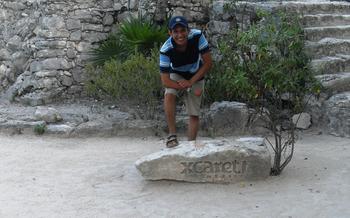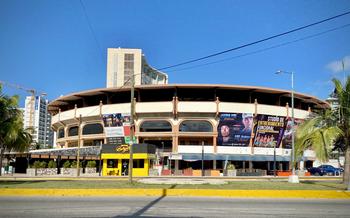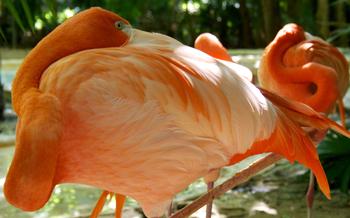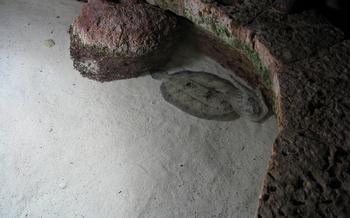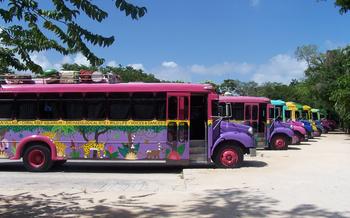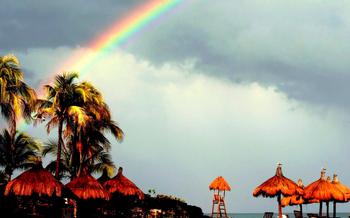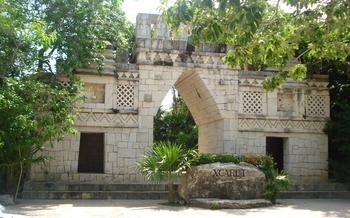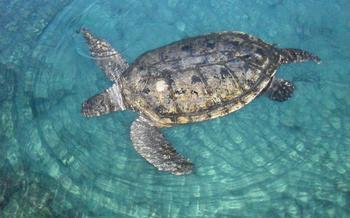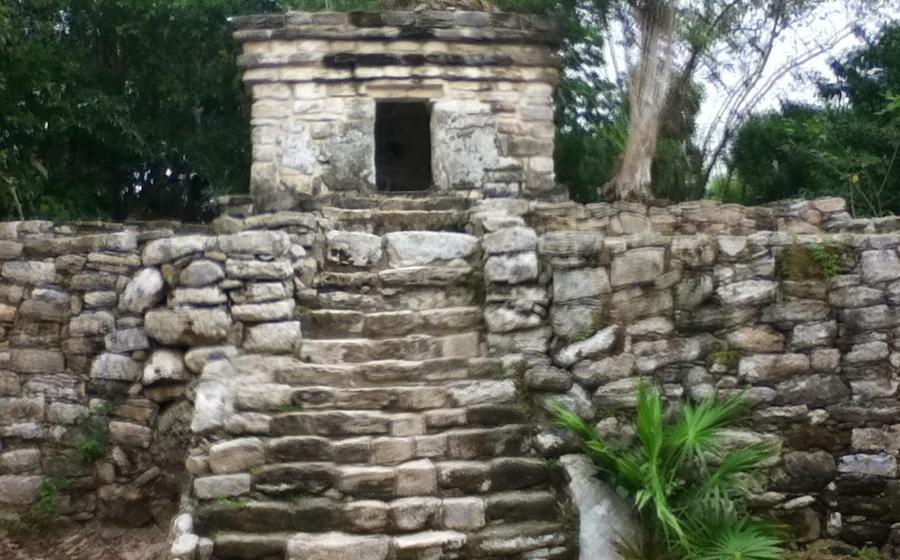
Cenote Calavera
- Xcaret Park
- Cenote Calavera: A Geological Wonder within Xcaret Park
- Cenote Calavera: A Unique Geological Formation
- Location and Accessibility
- Accessing the Cenote: Swimming, Snorkeling, and Diving
- Natural Beauty
- Cultural Significance
- Snorkeling and Diving
- Legends and Myths
- Flora and Fauna
- Guided Tours
- Amenities and Facilities
- Accessibility
- Best Time to Visit
- Sustainable Tourism
- Insider Tip
Xcaret Park
Xcaret Park is a renowned eco-archaeological theme park located on the Caribbean coast of Mexico, in the state of Quintana Roo. Established in 1990, it encompasses over 200 acres of natural beauty, Mayan cultural heritage, and modern entertainment. Xcaret combines thrilling attractions with immersive experiences, offering visitors a unique blend of adventure, history, and environmental conservation.
The park is divided into three main areas: the Eco Theme Park, the Archaeological Zone, and the Natural Reserve. The Eco Theme Park features various animal exhibits, aviaries, and interactive attractions, allowing visitors to encounter diverse wildlife species and learn about their conservation. The Archaeological Zone showcases the remnants of a Mayan settlement, including ancient ruins, plazas, and temples, providing a glimpse into the rich history of the region. The Natural Reserve, which includes the Cenote Calavera, offers breathtaking natural landscapes, pristine cenotes, and lush vegetation for exploration and relaxation.
Cenote Calavera: A Geological Wonder within Xcaret Park
Cenote Calavera: A Unique Geological Formation
Deep within the lush landscapes of Xcaret Park, a hidden gem awaits discovery: Cenote Calavera. This captivating natural wonder is a geological masterpiece formed by the collapse of a limestone bedrock, creating a breathtaking sinkhole that has filled with crystal-clear turquoise waters. The cenote's unique characteristics, such as its vertical walls and a narrow opening at the top, set it apart from other cenotes in the region.
Location and Accessibility
Nestled within the Natural Reserve area of Xcaret Park, Cenote Calavera is easily accessible via a short walk or by taking the scenic boat ride that meanders through the park's waterways. Once you arrive at the cenote, you'll be greeted by a staircase leading down to a wooden platform that serves as the entry point to this subterranean paradise.
Accessing the Cenote: Swimming, Snorkeling, and Diving
There are multiple ways to experience the beauty of Cenote Calavera. For those who prefer a refreshing swim, the crystal-clear waters offer an ideal setting for a leisurely dip or a vigorous swim. Snorkelers can immerse themselves in the underwater world, discovering a kaleidoscope of colorful fish, turtles, and other marine life that call this cenote home.
For those seeking a more adventurous experience, diving into the depths of Cenote Calavera is an unforgettable opportunity. Certified divers can explore the cenote's underwater caves and tunnels, encountering ancient rock formations, stalactites, and stalagmites that create an ethereal landscape beneath the surface.
Natural Beauty
The Cenote Calavera is renowned for its captivating natural beauty. Its crystal-clear turquoise waters, shimmering under the warm Mexican sun, create a mesmerizing spectacle. The cenote's depths reveal intricate rock formations, stalactites, and stalagmites that have been sculpted by time and water. The surrounding lush vegetation, teeming with diverse wildlife, adds to the enchanting ambiance of the cenote. Visitors can spot tropical birds flitting among the trees, colorful butterflies fluttering in the air, and graceful iguanas basking in the sun. The harmonious convergence of geological wonders and abundant wildlife creates a breathtaking natural sanctuary that leaves visitors in awe.
Cultural Significance
Cenotes were sacred places for the ancient Mayans, deeply embedded in their religious beliefs and rituals. They believed that cenotes were portals to the underworld, known as Xibalba, and that the water held mystical powers. Many cenotes were used for religious ceremonies, including offerings to the gods, purification rituals, and pilgrimages. People would come from far and wide to bathe in the cenotes, believing that the water would cleanse them of their sins and bring them closer to the divine. The Mayans also believed that the cenotes were inhabited by spirits and deities, and that by entering the water, they could communicate with the supernatural world. Today, the cultural significance of cenotes is still recognized and celebrated in the region, with many Maya communities continuing to use them for religious and ceremonial purposes.
Snorkeling and Diving
Cenote Calavera offers an immersive experience for snorkeling and diving enthusiasts. The crystal-clear waters provide excellent visibility, allowing you to explore the vibrant underwater world. Dive into the cenote's depths and discover a diverse array of marine life, including colorful tropical fish, turtles, and even the occasional stingray. Snorkeling equipment and scuba gear are available for rental, making it accessible for both beginners and experienced divers. Guided tours are also available for those seeking a more comprehensive exploration, with experienced instructors providing insights into the cenote's unique ecosystem and fascinating underwater formations. Whether you prefer snorkeling's tranquility or the thrill of scuba diving, Cenote Calavera offers an unforgettable adventure for all underwater enthusiasts.
Legends and Myths
The Cenote Calavera is shrouded in an aura of mystery and intrigue, with captivating Mayan legends woven around its depths. Stories of hidden treasures and mythical creatures echo through the cenote's chambers, adding to its allure. One enchanting tale speaks of a golden statue of a jaguar hidden within the cenote's depths, waiting to be discovered by a courageous adventurer. Another legend tells of a mystical creature known as the Aluxe, a mischievous spirit that protects the cenote and plays tricks on unsuspecting visitors. These legends and myths, passed down through generations, enhance the cenote's charm and make it more than just a natural wonder; it's a place where the boundaries of reality and imagination blur, leaving visitors with a sense of awe and wonder.
Xcaret Park often hosts cultural performances and reenactments that bring these legends to life. Visitors can witness traditional Mayan rituals, dances, and ceremonies, gaining a deeper understanding of the cenote's significance in Mayan culture. These performances transport visitors back in time, allowing them to experience the rich cultural heritage that surrounds the Cenote Calavera.
Flora and Fauna
Cenote Calavera is home to a diverse array of aquatic and terrestrial wildlife. The crystal-clear waters provide a sanctuary for various species of fish, including colorful tropical fish, eels, and catfish. Visitors may also encounter turtles, frogs, and other amphibians that inhabit the cenote's shores and surrounding vegetation.
The cenote's unique geological formations create microhabitats that support a variety of plant life. Underwater, visitors can observe delicate coral formations and a variety of aquatic plants that thrive in the cenote's unique conditions.
The surrounding lush vegetation is equally diverse, with a variety of tropical plants, trees, and flowers that provide a habitat for numerous bird species, insects, and reptiles. Visitors may spot colorful butterflies, hummingbirds, and other birds flitting through the foliage.
Protecting the delicate ecosystem of Cenote Calavera is of utmost importance. Xcaret Park has implemented strict conservation measures to ensure the long-term preservation of this natural wonder. Visitors are encouraged to respect the environment by avoiding littering, using biodegradable sunscreen, and following the guidelines provided by the park staff.
By promoting sustainable tourism practices and raising awareness about the importance of preserving natural habitats, Xcaret Park contributes to the conservation of Cenote Calavera and its surrounding environment, allowing future generations to experience the beauty and wonder of this unique natural wonder.
Guided Tours
To fully appreciate the cultural and historical significance of Cenote Calavera, consider booking a guided tour. Led by knowledgeable bilingual guides, these tours offer a deeper understanding of the cenote's unique geological features, Mayan legends, and the importance of preserving its delicate ecosystem.
Guided tours are available for various group sizes, from small intimate groups to families with children. The guides provide fascinating insights into the ancient Mayan civilization, their beliefs, and rituals associated with cenotes. They also share stories of hidden treasures, mythical creatures, and the connection between the cenote and the Mayan underworld, Xibalba.
By participating in a guided tour, you'll gain a deeper appreciation for the cultural and natural significance of Cenote Calavera, making your visit a truly enriching and memorable experience.
Amenities and Facilities
Cenote Calavera offers a range of amenities and facilities to ensure a comfortable and enjoyable experience for visitors. These include clean and well-maintained changing rooms, showers, and restrooms, providing privacy and convenience. To satisfy any hunger pangs, there are food and beverage options nearby, serving a variety of snacks, drinks, and local delicacies. For those looking to take home a piece of the cenote's magic, souvenir shops offer a selection of memorabilia, handcrafted goods, and local crafts that celebrate the region's rich culture.
Accessibility
Cenote Calavera is committed to providing an inclusive and accessible experience for visitors of all abilities. Wheelchair users can easily navigate certain areas of the cenote, including the viewing platforms and designated swimming areas. Life jackets and flotation devices are available for non-swimmers, ensuring everyone can safely enjoy the cenote's refreshing waters. Additionally, the park offers assistance for elderly visitors and families with young children, ensuring a comfortable and enjoyable experience for all.
Best Time to Visit
The best time to visit Cenote Calavera and experience its natural beauty without the crowds is during the dry season, which runs from November to April. During this time, the weather is pleasant, with warm temperatures and low humidity, making it ideal for outdoor activities. It's also advisable to avoid the peak tourist season, which falls between December and January, when the cenote can get quite crowded. For a more tranquil and serene experience, consider visiting during the early mornings or late afternoons, when the crowds are typically smaller.
Sustainable Tourism
Xcaret Park is committed to sustainable tourism practices, demonstrating its dedication to preserving the natural beauty and cultural significance of the region. Conservation efforts are at the forefront of their operations, with initiatives aimed at protecting the cenote and its surrounding environment. Xcaret actively works to minimize its ecological footprint by implementing water conservation measures, using renewable energy sources, and promoting recycling and waste reduction throughout the park. By encouraging responsible tourism, visitors are invited to become part of the conservation efforts, ensuring the preservation of this unique ecosystem for generations to come. Xcaret's commitment to sustainability sets a commendable example for other tourism destinations, demonstrating that economic growth and environmental protection can coexist harmoniously.
Insider Tip
To make your visit to Cenote Calavera even more seamless and enjoyable, take advantage of the complimentary transportation service offered by Xcaret Park. This convenient shuttle service operates from designated hotels in the Riviera Maya region, eliminating the hassle of arranging your own transportation. Simply check with your hotel's concierge or the Xcaret Park website for the pickup schedule and designated stops. This free service allows you to relax and fully immerse yourself in the wonders of Xcaret Park without worrying about logistics.
